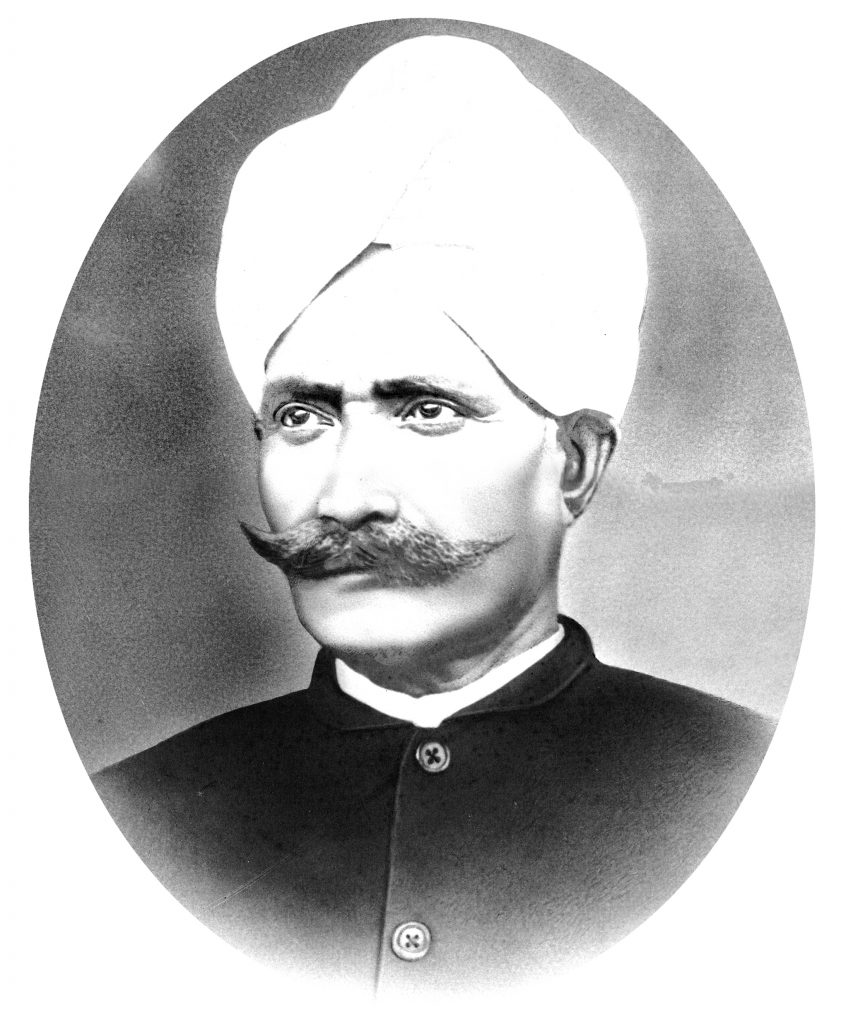The Naming Ceremony: -Ka Jer Ka Thoh
Tradition is a celebration of our roots,our heritage and the invincibility of their strength to protect our identity.The Khasis of Meghalaya practice a monotheistic religion, Ñiam Khasi. U Blei, the Great Divinity, the Super Consciousness that pervades the entire universe is imageless and formless Every piece of the earth is, therefore .sacred. Every home is a temple and every good deed,word and thought is an offering to U Blei unparalleled to any other.There are only three big ceremonies among the Khasis, Naming (Ka Jer Ka Thoh), Marriage (Ka Poikha Poiman) and Death-the last rites(Ka Iap Ka Duh). The only form of community worship is the Shad Suk Mynsiem, the thanksgiving dance held in spring each year, after the sowing season.
The most joyous moment in a Khasi home is the birth of a child .The birth of both boys and girls are welcome because we believe that “a home without a woman is like a body without a soul, a home without a man is a body crippled.” The Khasis are a matrilineal society. The lineage is taken from the mother and the head of the family is the eldest maternal uncle. The birth of a girl child is fervently prayed for, for the continuity of the clan and so for a boy too as in his sister’s house is the much revered mama. In his wife’s house he is the progenitor of the clan and the protector of family. He is, therefore, doubly honoured. In Khasi society the extinction of a family (duh iing )or a clan (duh jait) is considered a great misfortune.
The Khasi naming ceremony is referred to as Ka Jer Ka Thoh. Jer is a ritual associated with new beginnings, in this case to name a newborn child with the accompanying ritual. Housewarming used to be referred to as ‘jer iing’. Thoh is the smearing/ marking done by the priest on the baby with the pounded rice solution.
Soon after the baby is born the good news is first conveyed to the paternal grandparents.They come and visit bringing with them a vessel to heat bathing water and a jaiñ it,the long ,thick cotton scarf which is used as a strap to carry a baby on the mother’s back. A baby can be named anytime preferably within three months of its birth. It is an event filled with excitement as names are being chosen by the parents, family,friends and well wishers.
The night before the naming ceremony the Meikha sends the rice to be pounded the following morning. At the maternal home all the items needed for the ceremony are kept ready on a prah,a winnowing basket. The items are,
u skaw-a small bottle made out of a gourd
ka lakait – plaintain leaf
u khaw-rice
ka ja – cooked rice
u pujer- pounded rice
ka ryntieh – a bow
ki khnam – arrows
wait bnoh- a small dao
ka khoh- conical cane basket
u star- cane head strap for the khoh
ka rashi -a sickle
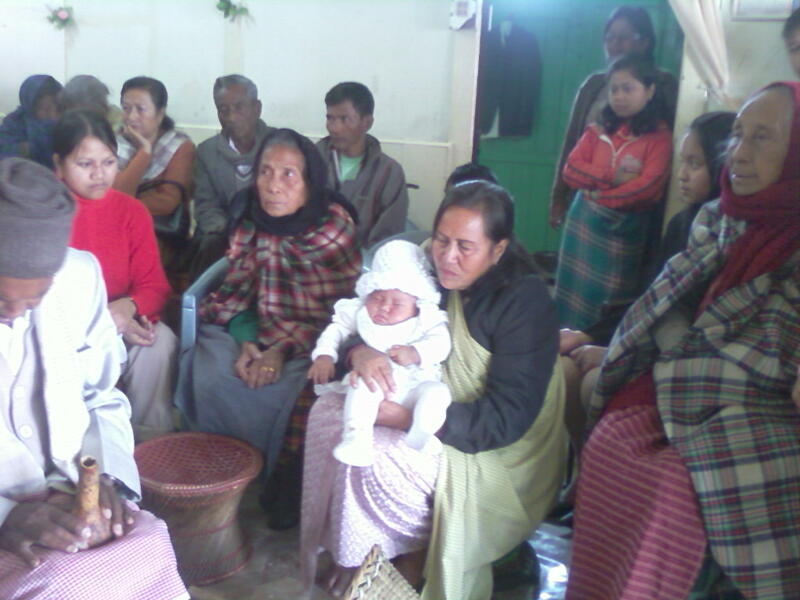
On the morning of the jer male relatives pound the rice in a thlong (mortar) with a synrei(pestle). A room facing East is swapped and cleaned and mulas (cane stools) are kept for the priest and participants. In front of the priest’s seat the prah with the items are kept.The members of the families enter and greet the priest and sit on their seats. The baby is brought and placed on the paternal grandmother’s lap. Then the puja pukan begins.
The priest mixes pujer (the pounded rice) with some water to form a thick solution inside the skaw, the gourd container.The priest begins with a prayer to U Blei, God Almighty, Lord Creator and then invokes the Ancestor and Ancestress , all the elders of the family who have passed on to bless the occasion.He prays that the baby may be blessed with good health and prosperity, success in all spheres,sound of mind and character ,one who will live by the tenets that has been taught since time immemorial. The tenets are Tip Kur-Tip -Kha,Tip Briew Tip Blei, Kamai Ia ka Hok.
Then the much – awaited moment, a unique part of the ceremony begins The priest calls out the chosen names one by one slowly and prayerfully. When the correct name,as willed by God, is called out a clot forms at the mouth of the skaw and remains there. There is always much rejoicing among those gathered there.
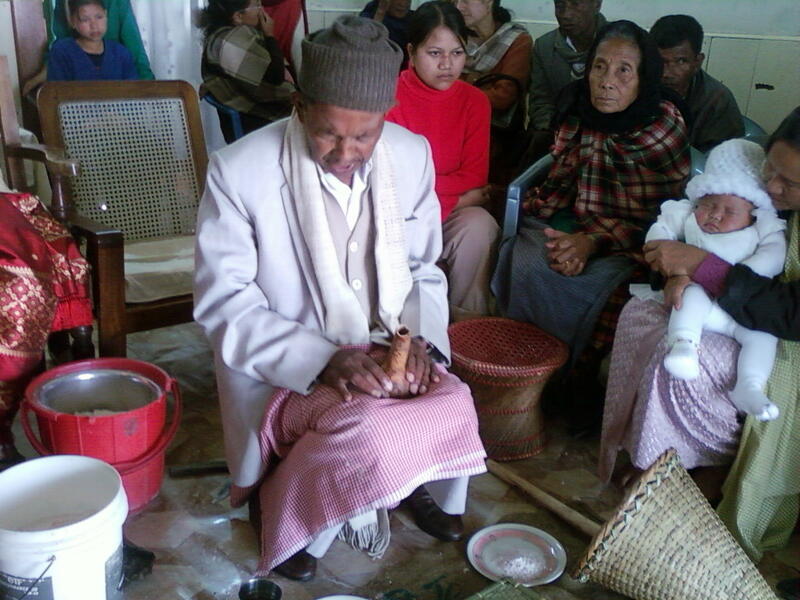
Next the father takes the jhep, the placenta and goes and places it on a tree .The Khasis believe that since the placenta has been the protective shield for the baby for nine months it should be given due respect and not be disposed off carelessly. When the father returns the baby‘s mama pours the water, which had been used at the puja, on the father‘s feet.
After that important ritual the baby is brought forward and the priest smears/thoh the baby’s left hand and foot with the rice and water solution, blessing the baby with the chosen name. He also extends this ritual on the mother and her family and on the father and his family on the right hand and foot.This marks the confirmation of the name and the end of the ceremony.
Traditionally, in the olden days, only the pujer mixed with sugar or savoured with dried fish are served along with tea. In the present times it has become an elaborate feast.
The naming ceremony,ka jer ka thoh, may differ slightly from place to place and from clan to clan but the spirit is the same. A child is born and the people rejoice for it means the continuity of the jaidbynriew which is essential for any race.
The Khasi Marriage Ceremony: Ka Shongkha Shongman
Traditionally, among the Khasis of Meghalaya, marriage is a coming together of two families,two clans and the match is ,more often than not,arranged. Many things have changed except for one rule – marriage into the same clan is strictly forbidden,it is an unforgivable transgression.The couple and children of such a match are ostracized by society. On the other hand legitimacy is every child:s birthright and the children born put of wedlock are accepted.

In the olden days, as part of a child’s upbringing etiquette is taught and relationships are explained based on the tip kur tip kha precept and the clan structure. During festivals and naming and marriage ceremony celebrations the young are encouraged to mix and parents and relatives hope to arrange a good and appropriate match for the children, nieces and nephews.ln the olden days,the decision as when the children are ready for marriage is interesting. The boy should be able to make a perfect shyngoid ,the wooden trough for feeding domestic animals. The girl is tested by her ability to roast a piece of dried fish just right for serving.
Once a prospective match is decided or if the boy and girl have expressed their wish to enter matrimony both families sit in conference. Calculations are done to ascertain that the match is appropriate.Besides the same clan issue other considerations are also discussed like past relationships between the two families have had no unpleasantness and tragic events.When the maternal uncles on both sides give the go ahead that everything is clear on both sides then the boy is allowed to visit the girl in her house accompanied by a young friend or cousin The girl, too,meets the boy wiith her sisters/cousins.The boy takes a few servings of kwai and once they are finished the boy leaves till the next meeting when the couple meet on their own
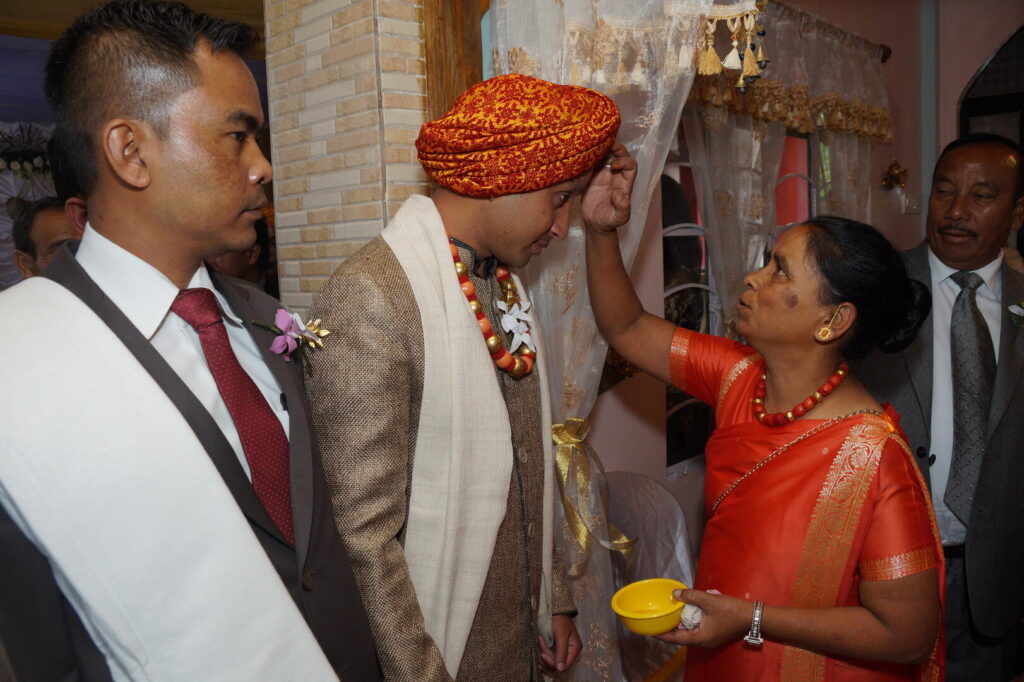
After a few meetings if the couple agree to get married then a formal proposal is sent to the girl’s house through a common lady friend or relative to fix a date for the meeting of maternal uncles .On the appointed day they meet and the proposal is formally done by the boy’s maternal uncle to the maternal uncles and parents of the girl.It is a formality for the girl’s side to reply that they would like a few days to give the answer.
Next meeting is again at the girl’s house where both families fix the date and decide on theplace where the groom will be received and how many will accompany him ,the rituals that will follow and so on.In the groom’s s party his male relatives led by a priest and mamas are followed by other relatives and friends.The parents of the groom do not join the baraat nor do the sisters .The boy’s father’s sisters are permitted and other female friends and distant relatives who are not his clan members.
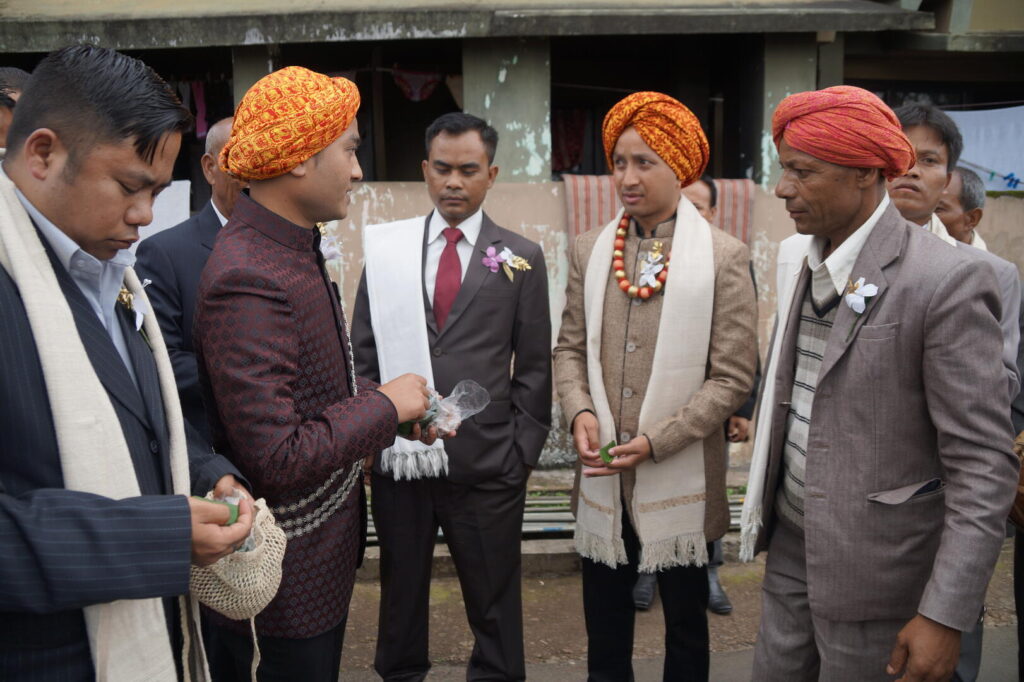
The clothes worn by the men are white dhoti, white turban and a shawl called ryndia tlem. Since the middle of the last century men wear suits with the turban and shawl. The women wear dharas in white , red or yellow but never black and dark colours.They also drape the ryndia tlem or sarot liehm. Their hair is neatly tied in a chignon and flowers are used for adornment.The jewellery worn is the gold choker ,the khonopad,the gold earrings, siar kynthei,the gold chain, kynjri ksiar and the bangles, khadu kyllaiñ.The men wear only a gold chain. Brides who are virgins do not cover their heads, they drape their shawl like a cape. Those who are not, cover with the ryndia tlem.
There are three types of marriages among the Khasis, pynhiar synjat, khawai lamdoh, khawai madan. Pynhiar synjat is no longer prevalent because it forbids remarriage even if the spouse loses the partner, if there are no offspring and the couple want to split, if there is incompatibility resulting in unhappiness and other unpleasantness . Khawai lamdoh is a ritualist ceremony which is lengthy and includes all the prayers and the ritual,‘ka suit ka shor’ which the priest performs. This ritual is only done if the bride is still a virgin. Khawai Madan which means Ordinary Feast is a meeting of the uncles of both sides who give their blessings and formalize the union. It can also include all the prayers but not ’ka suit ka shor ‘.The feast after the ceremonies depends entirely on the economic comfort of the bride’s family.As soon as the ceremony is complete a thali containing all the eatables that will be served to the guests is taken by a few relatives to the boy’s parents as a token of respect and to convey to them that the formalities are completed and all is well.
The rice that had been used for the ritual suit and shor is cooked separately for the couple for their first meal after the wedding. They eat it from the same plate. The feasting begins soon after for the guests. By the end of the ceremony it is usually early supper time. Normally rice dishes are eaten with various meat and fish delicacies along with salads, fried potatoes, saags and chutneys. Dal and exotic vegetarian dishes are a latter introduction. The feast is called lamdoh which literally translates into ‘bring the meat ‘. Earlier Khasis were mostly vegetarians and meats are served only during special occasions.
The exchange of rings which earlier was part of only the pynhiar synjat has now been incorporated into khawai lamdoh without the rules that governed the first mentioned form of marriage.The maternal uncle of the boy gives the ring to the girl and she puts it on.It is the same procedure with the boy ,the maternal uncle of the girl gives him the ring and he puts it on.The ring ceremony in which the couple put the rings on each other is not traditional but a Western adoption.
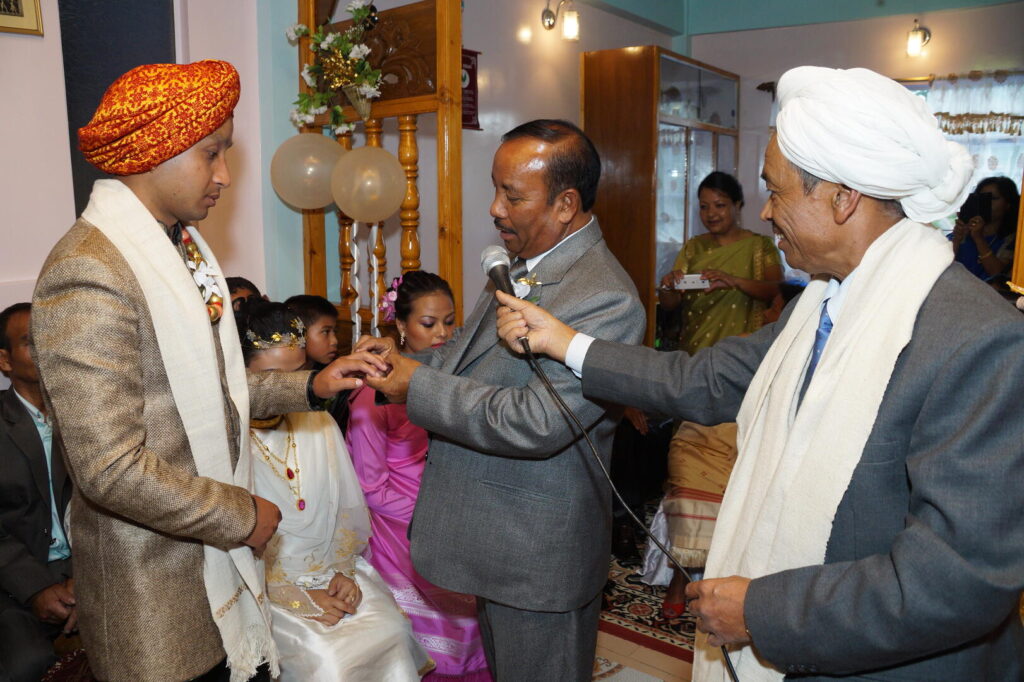
The prayers revolve around the basic foundation of marriage that the clan may increase blessed by male and female children. In traditional Khasi society both are welcome. Khasi society is a matrilineal society in which the lineage is taken from the mother and the maternal uncle is the head of the family. The man is doubly honoured for in his wife’s house he is the protector and progenitor of clan.
The day after the wedding the couple is expected to go out on their own, accompanied by close friends. In the olden days when dating was not allowed so this gave the couple the opportunity to be on their own. On the second day the girl’s parents take the newlyweds to the paternal grandparents’ home to pay their respects and traditional dishes like putharo and pudoh are specially prepared for them. At the grandparents home all the elders gather and one by one they smear a little oil on the couple ‘ s forehead and bless them. On the third day the couple accompanied by elders visit the groom’s parents.The same preparations are made and the mode of welcome is similar. A small party, a reception is held from the groom’s side to enable his relatives who were not present at the wedding to meet his wife. These three visits are never delayed because these formalities have to be completed before the bride gets pregnant.
Khasi brides always have bridesmaids. These young girls serve as attendants who help in wherever she does in order to help her and attend to her needs. Out of the two are chosen to attend to the food of the couple. They are all chosen from the immediate family.
The Seng Khasi was accorded with the power of registering marriages on June 23 2004. The awareness that marriages must be registered to ensure a certain code of conduct and values was expressed by Babu Jeebon Roy in 1897. He wrote ,”In my opinion Khasi society is now rife with immorality. To make marriage more formal and permanent we should adhere to the Marriage Act 111 of 1872. We must give special powers to syiems and sirdars to act as marriage registrars.”
Always a visionary and a forerunner, he understood the sanctity and importance of the institution of marriage. A healthy family life and progressive society are imperative for the survival of a race.
Bijoya Sawian is a translator and writer who lives in Shillong and Dehradun. She studied at Seng Khasi High School and Loreto Convent in Shillong, and did her Masters in English at Miranda House, Delhi, after graduating in English Literature from Lady Shri Ram College. Her works essentially deal with the life and culture of the Khasi community of North East India. The Teachings of Elders, Khasi Myths, Legends and Folktales and About One God are three of several books that she has translated from Khasi into English.

Kong Bijoya Sawian is an acclaimed translator and writer. The Teachings of Elders, Khasi Myths, Legends and Folktales, The Main Ceremonies of the Khasis and About One God are four of several books that she has translated from Khasi into English. Her works of fiction include Shadow Men -A Novel and Two stories (Speaking Tiger Books 2019) and A Family Secret and Other Stories (Zubaan2014).

